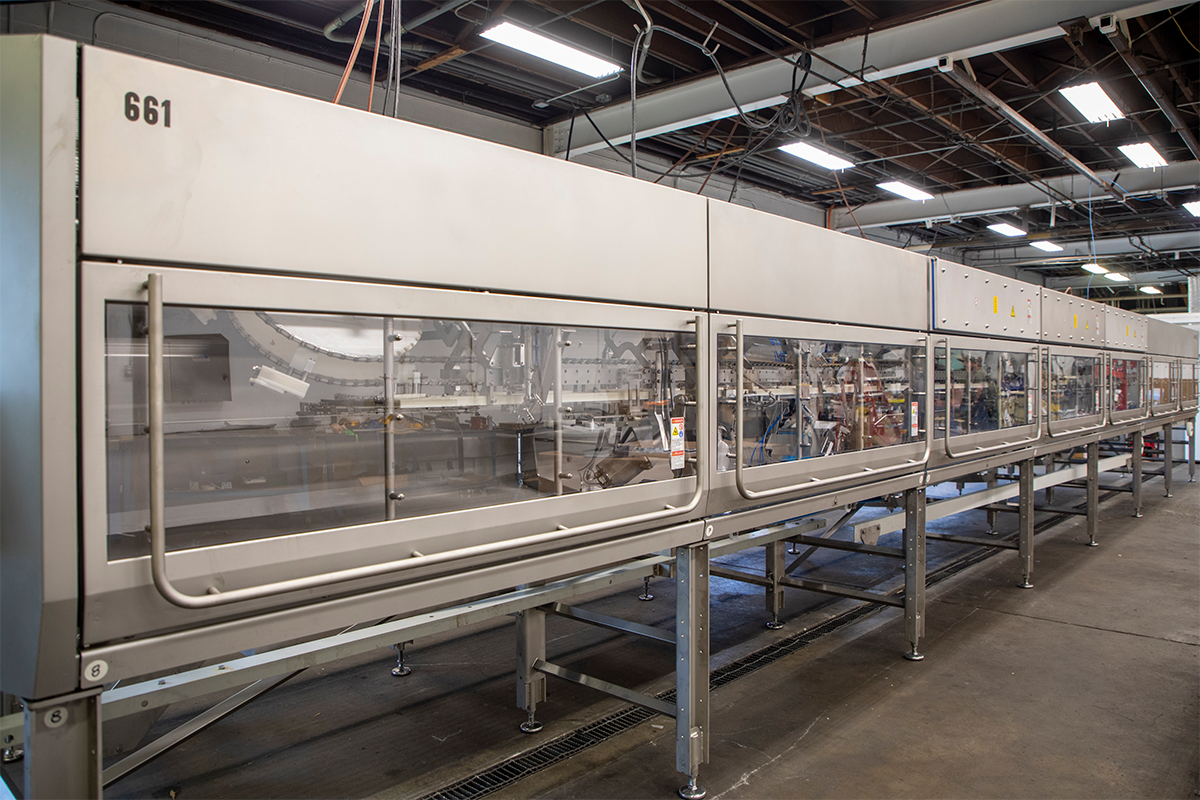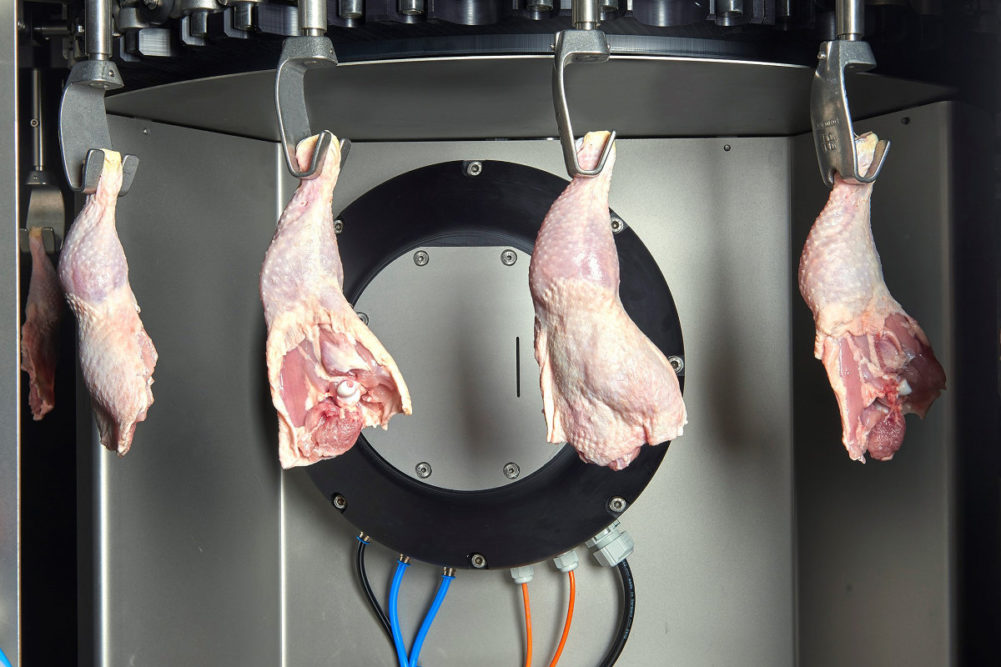Because of the huge and ever-increasing size of the American poultry industry, starting with hatching and going all the way to value-added chicken and turkey products, there is a lot that takes place in chicken and turkey processing. But four of the most critical elements in the poultry processing technology side of the industry include deboning, portion cutting, industry automation, and co-packing.
Hodie Meats, a poultry processing company, based in Alto, Ga., is a co-packer for well-known brands, as well as a deboner and portion cutter for poultry processors.
“Our business does co-packing for poultry processors and other types of poultry businesses, including prepared food accounts, national accounts and retail,” said Amy Ward, vice president of sales for Hodie.
“We’ve been doing co-packing for 15 years or more, including packaging and labeling. Some plants are not set up to do those things,” Ward explained. “We also upgrade products into more ready and usable raw materials. So, we have a great pack out capability.
“Co-pack specializes in labor-intensive items that poultry suppliers do not have the labor to do and allows for custom processes that are unique to individual customers,” Ward added. “Co-pack can run smaller-volume items.”
Full product folio
Hodie Meats does both deboning and portion-cutting. “We debone fronts, WOGs (without giblets, where the giblets and necks are not included, and where the whole young poultry may be split, quartered or cut into eight or nine pieces for the fast food or foodservice trade), saddles, whole legs, leg quarters, bone in thigh, and footballs.”
“For portioning, we do breast meat, tenders, and thigh meat to the customer’s specifications. We pack out 4/10 CVP or CO2 controlled vacuum pack and combos,” she said. “It gives you a longer life, 14 days in a standard industry pack.”
That refers to controlled vacuum pack chicken, an alternative to fresh ice-packed chicken. The chicken can be placed in a bag within a box, and it is modified atmosphere packed. After the bag is vacuumed and gas flushed, typically with CO2, it is heat sealed.
Hodie specializes in value added and portioned chicken. Back in December, the company announced that it was expanding with a new poultry processing facility in Georgia.
Marel supplies equipment to all sectors of the poultry processing industry, from the smallest to the largest, handling up to 15,000 broilers per hour, according to Larry Campbell, vice president of sales, poultry, for Marel.
“The type of equipment supplied will depend on the operations, which must be automated. It is often tailor-made to meet the local requirements and markets,” he said. “Marel also supplies equipment for turkey and waterfowl processors.”
Campbell said that co-packing is a natural fit for the poultry industry, even more so than other types of food processing, due to the increasing number of further-processed poultry products on offer. He said, “The advantage to the company that developed the product is that it remains the company’s product, and it does not have to invest in the people and equipment to make it.”
Campbell also talked about the difficulties in setting up an automated deboning line for a poultry processor, where one did not exist before.
“The pandemic forced everyone to be open to change – a change like deboning breast caps vs. traditional methods. Breast caps may be a new idea in North America, but the rest of the world has been doing it for more than 30 years, due to similar labor shortages that North America is facing today,” he pointed out. “We’re committed to and strive to deliver the automation that meets the needs of the ever-changing economic environment.”
Campbell described Marel’s most popular deboning equipment, such as the AMF-i, used in breast cap deboning; the FHF-HB, fed with front halves with wings or at least their inner joints left on, which are called “footballs.” The equipment is suited for all bird sizes, from small to big, and processes poultry into a variety of products, including butterflies, fillets, tenders, and whole wings.
Marel’s thigh fillet system harvests retail quality cuts and uses unique boning technologies. All is done automatically, in line, without any human labor or manual shackling. Campbell said vision and robotics has improved deboning equipment.
“Software is gaining importance. Food safety will play a central part in the future of food processing. Inspection devices like SensorX can be integrated on the line after deboning. Using high-end cameras is another new development that will ensure hygiene, product integrity and food safety, while saving labor,” he said.
 Baader's front-half deboner ensures maximum yield and minimizes labor costs by facilitating complex cutting processes. (Source: Baader)
Baader's front-half deboner ensures maximum yield and minimizes labor costs by facilitating complex cutting processes. (Source: Baader)
Function and flexibility
According to Alex Pangilinan, a marketing specialist at Baader in Kansas City, Kan., the company’s tools and equipment give poultry processors the flexibility to process each bird according to its individual characteristics for optimal results. Complete factories, functional areas, processing lines, and individual machines are served by Baader equipment, and through collaboration with the company’s poultry processing customers.
The company’s Uniload Live Bird Handling process begins at the farm, with a drawer system for easy catching and transporting of birds. There are two controlled atmosphere stunning options, above or below ground, based on customer preference.
The remainder of the slaughter line includes scalding and picking, then a high-speed evisceration line, including automatic giblet harvesting. The birds are then sent to Baader’s clean air chill system, then sorted for cut-up at the company’s Premium Pro-Flex Cut-Up Line, offering anatomical in-line wing segmenting and thigh filleting. The company also provides poultry evisceration and portion cutting to the industry.
“The Badder 661 Breast Deboner intelligently combines plant personnel and automation to obtain the highest quality and yield for poultry processors,” Pangilinan said. “We designed this system specifically for US poultry processors, including big bird plants. The machine saves skilled labor by automating complex cutting and scoring processes, while keeping our customers directly in control of the final product.”
He said the 661 deboner system, compared to manual deboning, saves customers 30 feet of valuable production space.
“Innovation has always been the most important part of what we do – both developing new systems, and bringing our current systems up to date,” he explained. “Our R&D consists of listening to our customers’ needs and expectations.”
Adam McCoy, national account manager for Foodmate, said the company provides equipment and services to poultry processors of all sizes, operating from small to very large plants.
“Our company provides small and large scale solutions after the chilling process, from grading whole birds to cut-up and deboning, continuing to batch weighing, slicing and dicing,” said Paul Breure, Foodmate project development manager.
“Our company’s specialty is dark meat deboning, with the speed ranging from 200 to 240 pieces a minute, with throughput and yields. We provide deboning for breast (white) and dark meat,” he said. “Our flagship machines are the OPTIX Thigh Deboner and the ULTIMATE Whole Leg Deboner, they are intelligent deboners with x-ray technology. We were the pioneers in intelligent deboning, utilizing x-ray technology and guaranteeing high yields and efficiency and high levels of return on investment.
Milan Wamsteker, global manager, marketing and communications for Meyn, Oostzaan, The Netherlands, said the company services the entire poultry processing market, including the 20 biggest processors in the world, but also small processors running low line speeds located in developing countries.
“We also have some customers in the Middle East and Africa, starting with speeds of 1,500 birds per hour, and growing to 8,000 or 9,000 birds per hour,” he said.
Wamsteker said Meyn supplies everything from live bird handling; truck unloading, hanging, stunning, to slaughtering, evisceration, chilling, cut-up and deboning, all at a possible speed of 15,000 birds an hour.
“Our hardware in combination with our software offers all the flexibility to provide retail and foodservice with the products needed,” Wamsteker explained. “Because poultry is a big numbers game, Meyn software allows the whole process to be optimized and create substantial cost savings, increase yield, and maximize profits.
“We can make the whole process from live birds to fillets possible at 15,000 birds an hour. Our machines also have the largest weight tolerance, so for us, lack of flock uniformity is less of an issue,” he added. So, flexibility is greater and overhead is less, the Meyn manager pointed out.



